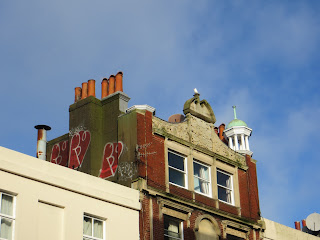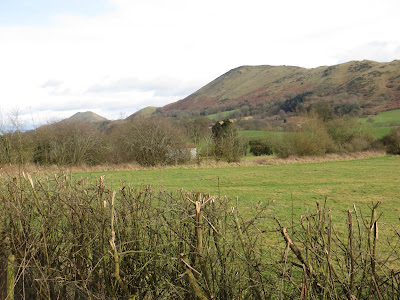Two hostels, both different styles of buildings, both in different kinds of location.
The first a converted town house in a city, the second a manor house in the country.
What other organisation can offer such a choice and confirm a continuing standard between both locations?
6 February - Brighton
On my previous cycle tours in the south of England I have always travelled by train to London and cycled from there. London to Brighton is no great distance, less than a day to cycle between the two cities. BUT - there is an obstacle between the two places in the shape of the South Downs. As attractive as they are they offer a serious challenge to the cyclist, constantly up and down hills with a final string in the tail at Ditchling Beacon before reaching the coast. The weather in February can be very unpredictable, for these reasons and the fact that for one night I really could not face hauling a loaded touring bike over the hills, I chose to travel by train all the way.
No takers for the beach to-day, the only point of interest being this sculpture, most of the sea front was fenced off for renovation, lets hope it is finished for the summer.
I was disappointed to find the main streets of the town occupied by people living rough. Almost every vacant doorway seems to house people asking for a donation to their living.
Every English seaside resort has at least one shop selling rock and sweet novelties.
Together with it's problem of people living on the streets, Brighton also sufferers from the attentions of graffiti 'artists'.
By contrast the hostel is a first class building in a perfect location just off the sea front and almost next-door to the Royal Pavilion. One of the fine town houses for which Brighton is famous it has been restored to a very high standard whilst retaining the original features. I also found it very pleasing that even this early in the year the accommodation was very full, ranging from student groups to individual travellers. It really is well worth a visit.
I have stayed in or passed through Brighton on several occasions and, for the first time, I have seen the Royal Pavilion - by both day and night.
George IV, as Prince of Wales began to visit Brighton in the late 1780's, primarily for drinking, gambling and 'entertaining' women. He had the Royal Pavilion built between 1815 and 1823 to enable him to have his fun in private - he became King George IV in 1820.
Due to ill health he only visited it twice after it's completion and died in 1830.
Due to ill health he only visited it twice after it's completion and died in 1830.
A beautiful building, this alone is worth a visit to Brighton.
20 February - Wilderhope Manor
Once again, a slight change to my usual method of travel. In place of travelling with a loaded touring bike I loaded my lighter weight road bike into my car and drove to Wilderhope Manor.
Built in 1585 the house was sold in 1734 and, it is believed, left empty until 1936 when it was purchased by the WA Cadbury Trust and gifted to the National Trust on the condition that it was used as a youth hostel, the role it fulfils to-day.
The building still retains it's original features, which blend in well with the modern facilities that go to make the accommodation welcoming and comfortable. To say the rooms are large is and under-statement, they are huge!
As I stand in the doorway it is remarkable to think that this is the same view the original owners would have had when the building was new in 1585.
Outside the farm next to the hostel is a horse made of horseshoes, and a bike not made of horseshoes.
Arriving just after mid-day and leaving the car at the hostel I cycled under the shadow of the remarkable Wenlock Edge.
On the way I passed through the village of Diddlebury. I feel sure there is a reason for this name, I expected to see a large cemetery where people went to bury their Diddles, but saw nothing.
Spring has arrived in England and with it the snowdrops are in bloom, quickly followed by crocuses.
The village of Longville in the Dale, a short distance from Wilderhope Manor.
21 February - Shrewsbury Circular
Above is a copy of a leaflet published by Shropshire County Council outlining the route of to-day's ride. It is designed as a 'leisure ride' to encourage cyclists to tour the area on quiet country roads. It is an idea route for both the experienced cyclist and those beginning or returning to cycling.
For convenience of parking (as recommended in the leaflet) I began the route at Shrewsbury Sports Village.
From here the route follows a stone path for a short distance, on the day of my visit made muddy by overnight rain.
This soon becomes a hard surface before joining quiet lanes for the ride to Upton Magna. This village was, for me, one of the highlights of the ride with an attractive church and several black-and-white half-timbered buildings which are a feature of the county.
After this the route turns north through more attractive villages than I can name until reaching Hadnall, where I wondered if this garden ornament was designed to welcome visitors of frighten them away.
At Haston the ride turns west before making it's way to Montford Bridge and heading south. Unfortunately at this point I was heading into a strong wind which took all my strength so decided not to stop and take photographs. Between Montford Bridge and Ford village there is a section of the busy A458 road. There is a narrow footpath alongside the road but the leaflet also shows an alternative route back into and out of Shrewsbury for those who are not comfortable on the main road.
Shortly after Lea the route begins to turn back to Shrewsbury and I was once more favoured with a tail wind.
At Atcham there is the very attractive 'Old Atcham Bridge', built in 1774 and spanning the river Seven.
Across the road from the bridge the route diverts through Attingham Park, an 18th century mansion and deer park, well worth a visit.

Leaving the park behind it is only a short ride back to Upton Magna and then to the finishing point.
It is not possible to travel in Shropshire, by whatever means, without encountering a hill or three. It cannot be helped, it is the nature of the county. With this in mind I must congratulate the planners at Shropshire County Council for planning this route to take in only gentle hills - with one exception, before Atcham there is a steep section, only short, but steep. After almost completing the ride it is no shame to have to get off and walk this one (I rode it).
43½ miles in total and well worth doing again.

































No comments:
Post a Comment